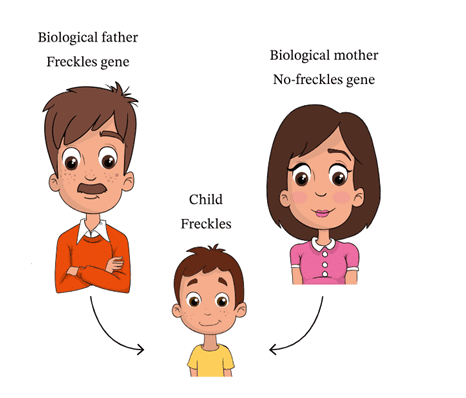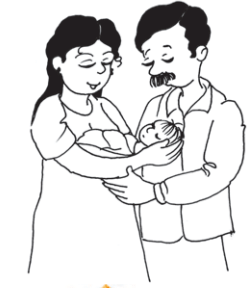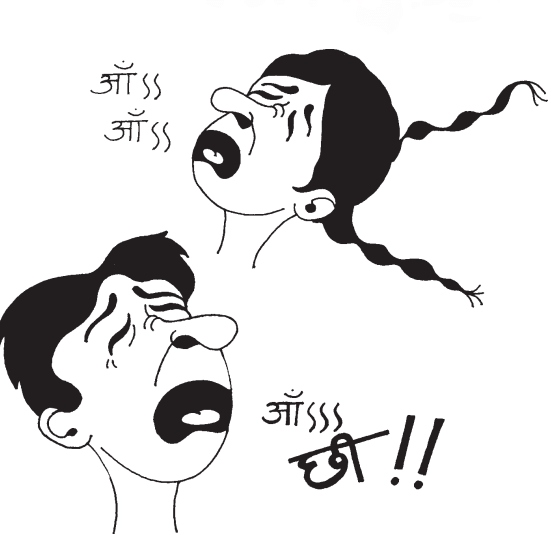HOTS Questions: Like Father, Like Daughter | EVS Class 5 PDF Download
Q.1. What is the reason why Saroja learned songs in Tamil and Marathi?
(A) She inherited this skill from her parents.
(B) She grew up in an environment where these languages were spoken.
(C) Her school taught her these languages.
(D) She took language lessons outside her home.
Answer: (B) She grew up in an environment where these languages were spoken.
 View Answer
View Answer 
Solution:
- Saroja's bilingual environment exposed her to Tamil and Marathi.
- The constant exposure to these languages helped her learn them naturally.
- This highlights the influence of surroundings on language acquisition.
Q.2. Which of the following statements about inherited traits is correct?
(A) All traits, such as speaking languages, are inherited from parents.
(B) Inherited traits come solely from the environment.
(C) Physical traits like hair color can be inherited, while language skills are learned.
(D) Inherited traits and learned traits are always the same.
Answer: (C) Physical traits like hair color can be inherited, while language skills are learned.
 View Answer
View Answer 
Solution:
- Inherited traits are passed down genetically (e.g., hair color).
- Learned traits, like language, come from environmental exposure.
- This distinction explains the difference between physical inheritance and learned skills.
 Inherited traits from parents.Q.3. In the story, Nilima’s curly hair resembles her nani’s hair. What is the term used for this type of trait transmission?
Inherited traits from parents.Q.3. In the story, Nilima’s curly hair resembles her nani’s hair. What is the term used for this type of trait transmission?
(A) Environmental influence
(B) Genetic inheritance
(C) Behavioral adaptation
(D) Cultural transmission
Answer: (B) Genetic inheritance.
 View Answer
View Answer 
Solution:
- Genetic inheritance refers to traits passed through genes from one generation to the next.
- Nilima’s curly hair, similar to her nani's, is an example of how physical traits can be inherited.
Q.4. Traits like curly hair and height are passed from parents to children through ________, which carry the genetic information.
Answer: Genes
 View Answer
View Answer 
Solution:
- Genes are the carriers of genetic information that determine traits.
- They ensure the transmission of physical characteristics from parents to offspring.

Q.5. Mendel’s work with pea plants helped scientists understand that traits are passed down from one generation to another, and this study is known as ________.
Answer: Genetics
 View Answer
View Answer 
Solution:
- Genetics is the study of heredity and how traits are passed through generations.
- Mendel’s experiments with pea plants laid the foundation for understanding genetic inheritance.
Q.6. How can environmental factors contribute to traits or habits that are similar within family members?
Answer:
- Environmental factors, such as the family’s lifestyle, habits, or traditions, can contribute to similar traits.
- Example: if a family listens to music regularly, children may develop a love for music.
- Similarly, the languages spoken at home shape linguistic abilities.
- Saroja’s exposure to music and languages in her home environment is a learned trait.
Q.7. How would you explain the difference between inherited traits and learned traits? Can you give an example from the chapter?
Answer:
- Inherited traits are passed down through genes (e.g., Nilima’s curly hair).
- Learned traits are acquired through environmental influence (e.g., Saroja learning music).
- In the chapter, Nilima's curly hair is inherited, while Saroja's musical skills are learned from her environment.

Q.8. In the story, Saroja knows songs in Tamil and Marathi, while Suvasini knows karate. What does this tell you about the impact of the environment on the development of skills?
Answer:
- Skills are influenced by the environment.
- Saroja learned music and languages due to her home’s musical and bilingual atmosphere.
- Suvasini learned karate because her father, a karate coach, encouraged her practice.
Q.9. Why do you think the chapter discusses polio and its misconceptions?
Answer:
- To educate readers that polio is caused by a virus, not an inherited trait.
- It aims to correct misconceptions about disease transmission and emphasize the importance of vaccination and medical care.
 PolioQ.10. How do you think family members can influence both inherited and learned traits in children?
PolioQ.10. How do you think family members can influence both inherited and learned traits in children?
Answer:
- Family members influence inherited traits genetically, passing down physical characteristics like hair type, height, or voice.
- They also influence learned traits through their actions and environment, teaching children skills, behaviors, and habits.
- Example, Nilima’s curly hair is inherited, but her interest in music could be learned.
Q.11. Why do you think Saroja’s mama uses a trick to differentiate between Saroja and Suvasini? What does this say about how twins can be both similar and different?
Answer:
- Saroja and Suvasini look very similar, making it hard for their mama to tell them apart.
- However, they have different skills and experiences due to the environments in which they grew up.
- This shows that while twins can share physical traits, their experiences and environments can make them very different in other aspects.
Q.12. How can observing traits in family members help scientists like Gregor Mendel in understanding genetics?
Answer:
- Observing traits in family members can help scientists understand patterns of inheritance.
- Gregor Mendel’s experiments with pea plants, where he observed traits like seed color and texture, helped him discover how traits are passed from one generation to the next.
- Similarly, observing human traits like hair type or sneezing patterns helps in understanding genetic inheritance.
 Gregor MendelQ.13. Why do you think Nilima realized that distant relatives are still closely related in many ways?
Gregor MendelQ.13. Why do you think Nilima realized that distant relatives are still closely related in many ways?
Answer:
- Nilima realized that even though some relatives are considered “distant,” they may share many traits, such as physical features or habits.
- This is because they still share common ancestors, and genes from those ancestors can be passed down across generations.
Q.14. What do you think Nilima means when she says, “We are called ‘distant’ relatives, but how closely related we are in many ways”?
Answer:
- Nilima is reflecting on how, despite being termed “distant” relatives, her family members share similar traits, such as curly hair.
- This shows that even distant family members can have strong genetic links that manifest in physical or behavioral traits.
Q.15. How can we use traits like laughter or voice to identify people in our families?
Answer:
- Traits like laughter, voice, or even the way someone talks can be distinctive to a person and may be shared among family members due to genetics.
- For instance, Vibha recognizes her nana by his unique loud laughter.
Q.16. Why do you think Mendel’s discoveries about pea plants were not understood during his time?
Answer:
- Mendel’s work was ahead of the scientific understanding of the time.
- The concepts of genetics and inheritance were not yet developed.
- His discoveries were only understood later as knowledge of genetics grew.
Q.17. How would you explain the concept of "dominant" and "recessive" traits using examples from the chapter?
Answer:
- Dominant trait: Appears even if only one parent passes it down (e.g., Nilima’s curly hair from her nani).
- Recessive trait: Appears only if both parents pass down the gene (e.g., brown eyes from parents carrying the recessive gene).
- Dominant traits overshadow recessive ones unless both genes are recessive.
|
37 videos|244 docs|41 tests
|
FAQs on HOTS Questions: Like Father, Like Daughter - EVS Class 5
| 1. What is the main theme of "Like Father, Like Daughter"? |  |
| 2. How does the father-daughter relationship evolve in the story? |  |
| 3. What lessons can children learn from "Like Father, Like Daughter"? |  |
| 4. Are there any specific traits that the daughter inherits from her father? |  |
| 5. What role does communication play in the father-daughter relationship depicted in the story? |  |
















